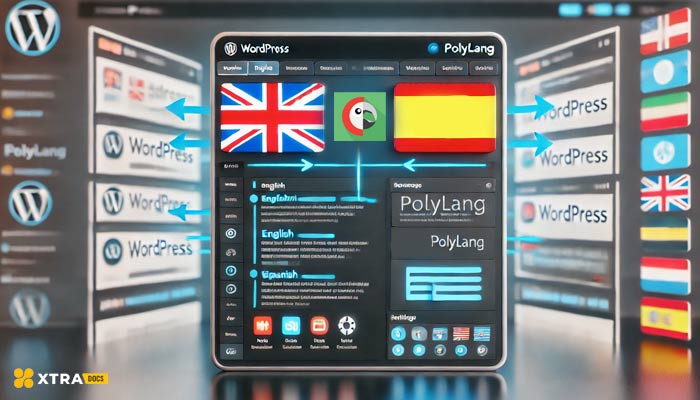Description and Screenshot
Translate your WordPress site using Polylang
Polylang is a popular WordPress plugin that allows you to create a multilingual website by translating your content into different languages. Below is a step-by-step guide on how to translate pages and important options using Polylang:

Step 1: Install and Activate Polylang
- Go to your WordPress Dashboard.
- Navigate to “Plugins” > “Add New”.
- In the search bar, type “Polylang”.
- Install the plugin and then click Activate.
Step 2: Set Up Your Languages
- Once activated, go to “Languages” > “Languages” in your WordPress dashboard.
- Add Languages:
Click the “Add New Language” button.
Select your desired languages from the drop-down list.
Set the language code, flag, and order if necessary.
Repeat this process to add all the languages you want on your site.
Step 3: Configure Polylang Settings
- Go to “Languages” > “Settings”.
- Choose Default Language:
Select which language you want to be the default language of your site.
- URL Settings:
Choose how you want to structure your URLs for different languages (e.g., by using subdomains, directories, or parameters).
- Synchronization:
Configure the synchronization options to decide which content elements (like media, categories, etc.) should be shared across translations.
Step 4: Translate Pages and Posts
- Create a New Page or Post:
Go to “Pages” > “Add New” or “Posts” > “Add New” to create a new page or post.
- Add Content in Default Language:
Write your content in your default language.
Publish or save the draft.
- Add Translation:
After saving the default language page, you will see language options in the Polylang meta box or language switcher section.
Click the “+” icon next to the language you want to translate the page into.
This will create a new page or post where you can enter the translation.
Translate the content into the desired language and publish it.
Polylang will automatically link this translated page to the original page.
Step 5: Translate Menus
- Go to “Appearance” > “Menus”.
- Create or edit a menu for the default language.
- After saving the menu, switch the language using the language selector at the top of the page.
- Create a new menu for each additional language by repeating the steps.
- Assign the translated menus to the appropriate theme locations.
Step 6: Translate Widgets
- Go to “Appearance” > “Widgets”.
- Select the widget area where you want to add or translate widgets.
- Add widgets as usual.
- Configure widget visibility:
Use the language settings in the widget options to display the widget only for specific languages.
This can be done by clicking the “Languages” option in the widget settings.
Step 7: Translate Custom Post Types, Taxonomies, and Options
Custom Post Types:
Ensure that your custom post types are set to be translatable under “Languages” > “Settings” > “Custom Post Types and Taxonomies”.
Follow the same process as translating pages and posts.
Taxonomies (Categories, Tags, etc.):
Go to “Posts” > “Categories” or “Tags”.
Translate them by clicking on the “+” icon next to the language you want to translate them into.
Theme Options:
Some themes or plugins have options that can be translated directly in the theme options panel.
If your theme or plugin is compatible with Polylang, you will see language flags next to each option that can be translated.
Step 8: Set Up Language Switcher
1.Add a Language Switcher to the Menu:
Go to “Appearance” > “Menus”.
Add the Polylang Language Switcher to your desired menu location.
Customize how the switcher appears (e.g., show flags, language names, etc.).
2.Add a Language Switcher as a Widget:
Go to “Appearance” > “Widgets”.
Drag and drop the Polylang Language Switcher widget into your desired widget area.
Configure its display settings.
Step 9: Verify Translations
- Preview your site in different languages by using the language switcher.
- Check that all content (pages, posts, menus, widgets, etc.) displays correctly in each language.
- Test navigation to ensure that users can switch between languages smoothly.
Use Polylang’s String Translation
Step1:
1.Go to “Languages” > “String translations“ in your WordPress dashboard.
2.On the String Translations page, you will see a list of strings (text elements) used in your theme and plugins.
3.Find Theme-Related Strings:
You might need to search through this list to locate strings related to your theme.
Use the search filter to quickly find the specific strings.
4.Translate the Strings:
For each string you want to translate, click on the field corresponding to the different languages and enter the translated text.
For example, if you have a theme option in English and you want to translate it to another language, you would enter the translation in the appropriate language field.
Step 2: Save Translations
After entering all the translations, make sure to Save the changes.
Step 3: Verify Translations
Preview your site in different languages using the language switcher to ensure that the translations are correctly displayed.
By following these steps, you can successfully translate the theme options in WordPress using Polylang’s String Translation feature.
You may want to know …
- SEO Configuration: Polylang works well with popular SEO plugins like Yoast SEO. Make sure to configure the SEO settings for each language.
- Consistency: Ensure that your translations are consistent across your site to provide a seamless user experience.
- By following these steps, you can effectively translate your WordPress site using Polylang and manage a multilingual site.
For better and more comprehensive learning, visit the Polylang documentation website.